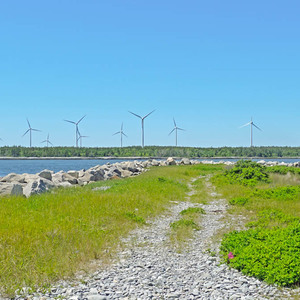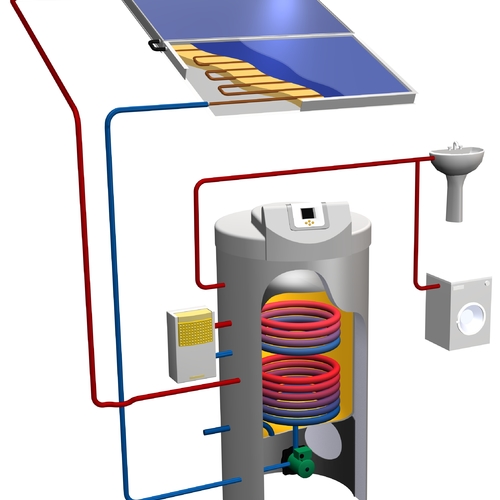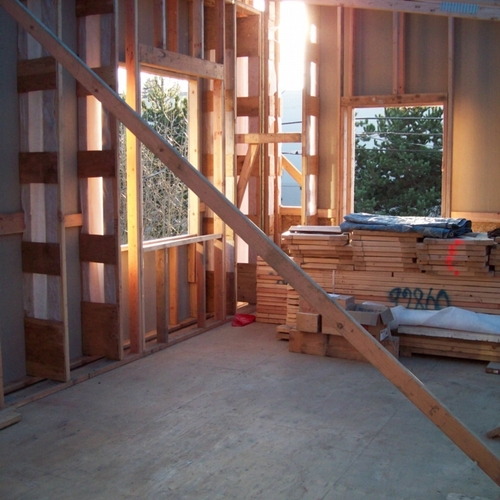Image Credit: Alex Wilson
Image Credit: Alex Wilson This photovoltaic system in southern Vermont can provide backup power during power outages.
Image Credit: Alex Wilson This solar water heater on a Guilford, Vermont, home is augmented by a heat exchanger in the wood stove, which offers backup water heating in the event of a power outage — relying on passive thermosiphoning.
Image Credit: Alex Wilson
House location and design are the starting points in achieving resilience — where the house located, how well it can weather storms and flooding, and how effectively it retains heat and utilizes passive solar for heating and daylighting. Beyond that, we should look to more active renewable energy systems for backup heat, water heating, and electricity. This week we’ll review these options.
Wood stoves
In rural areas, clean-burning wood stoves provide an easy option for backup heat. With a compact, highly energy-efficient (resilient) home, a single small wood stove can effectively heat the entire house when there is a power outage or interruption in heating fuel. Even in our current home, which is far from what I would call a “resilient” (relative to energy performance), we use a wood stove as our primary heat source — albeit accepting significantly cooler temperatures in parts of the house that are distant from the wood stove.
Wood stoves are dirty, though — even EPA-compliant models (as all new wood stoves sold new today must be). In a rural area, such as where I live, reliance on wood heat may be acceptable, but in more densely populated areas, extensive use of wood heat would cause significant pollution problems. Even in our area, when there is a power outage and more residents fire up their wood stoves, the air quality deteriorates. Thus, wood heating makes the most sense when the house to be heated is highly energy-efficient so that little wood needs to be burned to maintain comfortable, safe conditions. And then, the wood stove should be operated for maximum combustion efficiency (minimum smoke production).
Pellet stoves
Like wood stoves, pellet stoves can do a good job of heating an energy-efficient house. Because of the fan-supplied combustion air, pellet stoves tend to be much cleaner-burning than wood stoves. The need for electricity to operate, though, makes pellet stoves inherently less resilient.
Our pellet stove — the sole heat for the apartment above our garage — works like most pellet stoves when AC electricity is available: electric coils ignite the pellets during start-up, a fan brings combustion air to the burn-pot in the stove, and another fan blows the heated air into the room. In the event of a power outage, however, our pellet stove — unlike most — can still be operated. The fans in our Quadra-Fire Mt. Vernon AE have DC motors, and we have jumper cables that allow us to operate the stove during a power outage by clipping them to an automotive or other deep-cycle 12-volt battery. This backup power isn’t enough to start the pellet stove (we have to do that manually with pellet starter gel or some kindling), but the battery can power the two fans.
Solar electricity
The ultimate in resilience can be achieved with a solar-electric (photovoltaic) power system that can be used when the grid is down. Photovoltaic (PV) systems directly convert sunlight into electricity. PV modules can be installed on a roof or on ground-mounted racks. Most use silicon wafers that are specially made so that photons of light excite electrons and generate direct current (DC) electricity. An inverter in most PV systems then converts that DC electricity into alternating current (AC) that can be used by standard household appliances and also fed into the utility grid through a net-metering system.
The problem with most grid-connected PV systems is that when the grid goes down (during a power outage), you can’t use the electricity. This is a safety feature with grid-connected PV systems to prevent them from feeding electricity into the power grid when linemen may be repairing down wires. To serve as a power source during a power outage (key to resilience), it is generally necessary to install some battery backup and a “hybrid” PV system. These systems are more complex (and costly), because they include not only a battery bank, but also controls that send power either to the battery bank or power grid, depending on the charge state of the batteries and status of the grid. There are apparently some specialized inverters that allow electricity to be used in the home (during the daytime when the PV system is producing electricity) even when the system is disconnected from the grid during an outage, but these inverters are uncommon.
Solar water heating
To heat water when the electric grid is down, the best option is a solar water heating system that can operate without AC electricity. Some “active” solar water heaters have DC pumps with integral PV modules that operate the pump when the sun is shining — thus the PV module serves both as the controller and the pumping power. There are also two types of passive solar water heaters that require no electricity. Thermosiphoning systems have the solar collector mounted below the storage tank, and solar-heated water rises through natural convection into the storage tank when the sun is shining. With batch or integral-collector-storage (ICS) solar water heaters, the water is stored right where it is heated (with water pressure delivering that water to a collector on the collector on the roof).
A solar water heating system can be augmented with water heating coils in a wood stove to ensure adequate hot water during the winter months when there is less solar energy.
About this series
Throughout this resilient design series, I’m covering how our homes and communities can continue to function in the event of extended power outages, interruptions in heating fuel, or shortages of water. Resilient design is a life-safety issue that is critical for the security and well-being of families in a future of climate uncertainty.
Alex is founder of BuildingGreen, Inc. and executive editor of Environmental Building News. To keep up with his latest articles and musings, you can sign up for his Twitter feed.
Weekly Newsletter
Get building science and energy efficiency advice, plus special offers, in your inbox.















6 Comments
Have thougt about a small PV
Have thougt about a small PV / DC / battery system for my retirement home. Just big enough for a few lights and an inverter for using my computer / charging my phone during an outage. Would wire a few light locations and a few inverter outlets. Would provide outdoor and security lighting.
During an outage I could always pull out my camping solar shower and camping propane stove.
Not a fan of wood or pellet stoves in an urban area, so my emergency space heating would be a sweater and wool socks.
One aspect of resilient design is "future proofing" a house. Run wire or conduit from the electric panel to the attic or roof for future PV. Install pipes from DHW to attic or roof for future solar thermal. Roof and gutters that could harvest rainwater.
"Green" wood burning...
I will be using a woodstove as the primary heating appliance in my home.
I love my little stove:
It doesn't require electricity.
I can harvest my own wood from the property.
My "pretty good house" won't need that much wood to keep warm.
Little enough that I will be able to split it all with a maul - though some help would be nice.
No fuel tankers required and therefore no keeping the driveway plowed wide enough for a tanker.
I used to call this type of thing "off-grid capability" but "resilient design" or "passive survivability" are better terms.
I think it's a pretty important yet neglected concept.
Alex,
I enjoyed this article.
And not just the part about woodstoves.
I also enjoyed reading about pellet stoves, PV and solar thermal.
Though I'm not sure I agree that "The ultimate in resilience can be achieved" with PV...
EV Charging Outlet
One thing I forgot on futureproofing a house is to install or at least prewire for an EV Charging Station. Fossil Fuel private autos will become rare or obsolete in the lifespan of the houses we are building today.
Wood stoves and pellet stoves have there place in well insulated, RURAL homes. I live in a city and the few homes still burning wood are using wood to overcome a terribly poor insulated home.
On our occasional very cold day, the whole neighboorhood can smell one or two homes burning wood.
Even now let alone the near
Even now let alone the near future, the idea of woodstove heat is rediculous for the world is just way too populous for such to be part of a green building advisor site. You and I live rural and where it's ok, but the best solution for the masses is to live where heat can be done without. That is the basic way to deal with no power.
The blog would makes sense if it only reached the less than 1% that it made sense for.
How do you rewrite this blog so that all 7 billion have an answer? And at 1% population growth change my 7 billion to 14 billion in one lifetime. 28 billion in two lifetimes. 56 billion in three lifetimes. The day of less humans is coming soon whether we like it, or not. Less is going to have to be better than more. But right now no one knows how to live each day with less. But we are starting to be forced to learn. Will the next Pope finally figure out that each Catholic will need to only bear their replacement? What day a that will be.
Exponential growth of the population on Earth has to level off and it will. Look at some of the graphs on this page that have to do with the growth of technology and more. 45% growth rate for digital computing. The future is about to be the wild west all over again.
http://www.singularity.com/charts/page70.html
To understand exponential growth or decay, watch this series.
https://www.youtube.com/watch?v=F-QA2rkpBSY&feature=list_related&playnext=1&list=SP6A1FD147A45EF50D
Another interesting tidbit when searching decay...
"In history of science, some believe that the body of knowledge of any particular science is gradually disproved according to an exponential decay pattern (see half-life of knowledge)"
Sounds like how in just a decade of Taunton discussions... we have started to prove this.
How Buildings Learn
It's good to plan for future needs but a mistake to think we can predict those needs reliably. EV charging may become a standard feature during our lifetime or it may not, and the charging station we eventually may need could be substantially different than what we'd install now: hydrogen? compressed air? plutonium? Well, OK, no plutonium. But I'd suggest we don't have to install a charging station now, ahead of need, as long as our home as the flexibility to easily add one later.
Of course there are many 'unknown unknowns' in our future, so that same flexibility may serve many as-yet unidentified future needs. Having spent a lot of time wrestling with intractable slabs and cathedral ceilings in our extensive renovation work over the years explains why I generally have a strong preference for accessible crawl spaces and attics in new construction, to make future adaptations to changing circumstances relatively easy and nonintrusive.
The plea for flexibility is really a general comment on this series by Alex, not restricted to this particular post. And if you're not already familiar with it I strongly recommend Stewart Brand's 1994 book 'How Buildings Learn' (later also a BBC TV series) - especially his chapter on scenario-buffered design, which is concerned with extending the standard design program to consciously allow for an unpredictable future. Good reading.
“All buildings are
“All buildings are predictions. All predictions are wrong.”
Log in or create an account to post a comment.
Sign up Log in